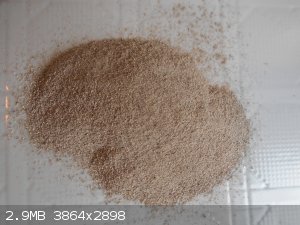BaFuxa
Hazard to Self
 
Posts: 61
Registered: 18-9-2017
Location: Mars
Member Is Offline
Mood: Buzzing
|
|
Is This Aluminum Oxide ?
Hi,
I accidentally left some aluminum chloride sit on the hotplate. I got beige chunks that I then ground and dried further.
I ended up with this.
According to a procedure regarding the synthesis of aluminum chloride this should be aluminum oxide. This is perfectly reasonable as 2 AlCl3 + 3 O2 +
heat -> 2 Al2O3 + 3 Cl2
Problem is I weighed 1 ml of this fine sand and I got 0.5g  . Far from the 3.97
g/ml( Al2O3) I was hoping to get near. Even elemental Aluminum is heavier than that with 2.97g/ml . Far from the 3.97
g/ml( Al2O3) I was hoping to get near. Even elemental Aluminum is heavier than that with 2.97g/ml 
So I am scratching my head, what is this feathery sand I have here ? It should be Al2O3 but maybe the impurities that impart the beige/sandy color are
pushing the Al2O3 molecules apart thereby decrease the density of the sand ? What do you think ?

[Edited on 17-2-2018 by BaFuxa]
[Edited on 17-2-2018 by BaFuxa]
Potential counts for nothing until realized.
|
|
|
DraconicAcid
International Hazard
    
Posts: 4333
Registered: 1-2-2013
Location: The tiniest college campus ever....
Member Is Offline
Mood: Semi-victorious.
|
|
The reaction would not be as shown, but 2 AlCl3 + 3 H2O --> Al2O3 + 6 HCl. Aluminum chloride will not become anhydrous before decomposing. Even
the above equation isn't accurate- the product would also contain hydroxides and chlorides. The colour suggests that it's contaminated with iron(II)
oxide as well.
You cannot determine the density of a feathery sand like that, because the volume is mixture of that of the particles and the space between them. If
you've measured out 1 mL of it in a graduated cylinder, add 1 mL of water and see what the total volume is once the particles settle to the bottom.
Please remember: "Filtrate" is not a verb.
Write up your lab reports the way your instructor wants them, not the way your ex-instructor wants them.
|
|
|
RawWork
Hazard to Others
  
Posts: 167
Registered: 10-2-2018
Member Is Offline
|
|
Use your nose. If it smells like HCl, then it's chloride. Unlike more ionic compounds like alkaline and alkaline earth chlorides, AlCl3 hydrolyzes in
water to release HCl, which may redisolve so AlCl3, Al2O3 and similar may coexist in water. But they will always smell like HCl. Even dry AlCl3 as air
will have moisture, or try adding few drops on water.
If it doesn't smell, then it's more likely Al(OH)3, which some people consider Al2O3 hydrated.
[Edited on 17-2-2018 by RawWork]
|
|
|